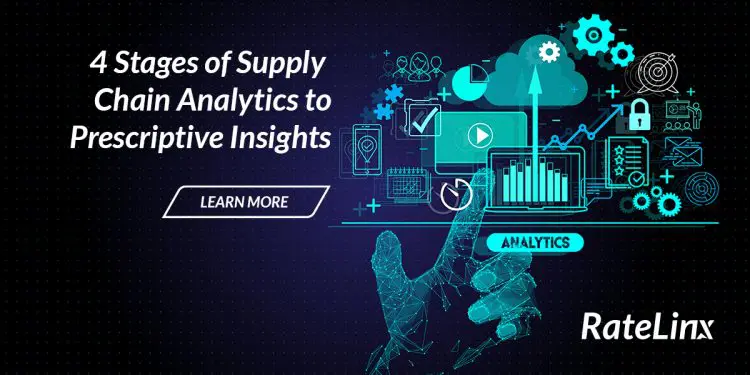As we step into a new year with 2020 in the rearview mirror, our global supply chains are forging ahead. Many are focusing on supply chain analytics, doubling down on technology, automation, and risk management to improve in 2021.
Above all, supply chain improvement initiatives this year emphasize more proactive and less reactive decisions. This applies to planning, execution, and forecasting—a common theme over the last year as supply chains adapted, shifted, and struggled through the challenges of 2020. Here, we examine four stages of supply chain analytics and how to improve supply chain decision-making with prescriptive insights.
4 Stages of Supply Chain Analytics
- Descriptive Analytics – Describes what happened
- Diagnostic Analytics – Why did it happen
- Predictive Analytics – What will happen next
- Prescriptive Analytics – What should we do
The Power of Proactivity
Most large shippers are conglomerates, comprised of smaller companies, each with different systems, processes, and people. Of course, each business unit must communicate, integrate, and execute collaboratively to keep the supply chain running.
In complex organizations, getting insights that are accurate, complete, timely, and accessible, that is to say, usable—is difficult. As a result of these problems, many organizations rely on reactive instead of proactive decision-making in their supply chain operations.
Daniel Stanton, author of Supply Chain Management for Dummies, says, “One challenge is that many supply chain leaders treat data quality as an operational or tactical issue, and assume that someone in IT is taking care of it. That can be dangerous because IT doesn’t often understand the interrelationships within the supply chain well enough to implement the right kinds of data governance processes. These gaps often surface in the middle of a crisis, when you desperately need complete and accurate information on which to make decisions.”
43.5% of logistics professionals cited “accuracy, completeness, and timeliness of insights” as the biggest concern in their current TMS and related processes.
July 2020 Supply Chain Dive survey results.
The difference between a decision about something that happened yesterday or last week versus tomorrow or next week can be half a million dollars. Not to mention, lost efficiency and a negative impact on customer service.
Improve Supply Chain Decision-Making with Prescriptive Analytics
What if supply chain analytics could predict what is likely to occur in the future, based on historical data, business rules, rates, and modes used? Imagine if you could alert the logistics team to upcoming issues before they happen. What if the system could automatically take action based on data? And make changes to the network that generally take days, weeks, or even months after-the-fact?
Rather than spending the first two weeks of each month hunting, digging, and poring over data to understand why you blew last month’s freight spend budget, what if you received an alert a week into the month that your daily freight costs were higher than anticipated and switching to a different carrier could save you $1 million a day? The power of prescriptive insights is being able to make great business decisions faster.
It All Starts With the Data
To get to prescriptive insights, we need to start back at what feeds all supply chain analytics and insights: data. Transportation and logistics data in an organization results from upstream supply chain decisions and feeds the tools to react and communicate changes. The upstream supply chain, including sales, customer service, planning, scheduling, and manufacturing, provides the information necessary to manage logistics proactively using prescriptive insights.
Often in large (or small) organizations, siloed data in various systems, spreadsheets, and databases is difficult to access. Furthermore, it takes too long to manually manipulate and interpret the data to provide any real value.
Supply chain professional and owner of Buyers Meeting Point, Kelly Barner, adds, “Every company has a data problem. Data is being created at an unthinkably fast rate. We can hardly stop operational progress just so we can get our data cleaned up and our data management systems set up.”
Barner offers recommendations for quality data in organizations. “There should be one single source of truth for data, enterprise-wide, and it should be possible to pull data directly from the system to prevent human errors in calculation or a mismatch when the team wants to reconcile data again later,” she says.
Typically, users won’t trust data they can’t access or analyze. As a result, predictive or prescriptive analytics are not possible if supply chains can’t access, use, or trust their analytics.
Data Quality: Accurate, Complete, and Timely Data
To improve insights, an organization must first evaluate the information’s accuracy, timeliness, and completeness. For example, is it trustworthy and factually correct? Is it up-to-date (preferably live)? Is it missing any key components?
For this evaluation, it’s crucial to understand and define “data quality”. Data quality is defined as data that represents the real world it describes and is fit for its intended use.
To use predictive analytics effectively, the organization must have accuracy and trust in their data and analytics. In addition, it’s imperative the data is standardized, normalized, and cleansed. Otherwise, decisions, plans, and forecasts are made from poor data, creating doubt and increasing risk.
Cathy Morrow Roberson, Founder and President of Logistics Trends & Insights, LLC, offers this feedback, “People need to understand how to identify the right data, analyzing data appropriately and ongoing maintenance. Without maintaining data quality, an important business decision could backfire.”
As we dive into the four stages of supply chain analytics, it’s essential to take a data-first approach and get all logistics data sources in one place so it can be interpreted and used.
Like what you’re reading?
Stage 1: Descriptive Analytics
The first stage of supply chain analytics is descriptive analytics—using data to describe what happened. We see that most supply chain and logistics professionals are trying to get here. They struggle to answer questions about what happened yesterday, last week, last month, or last year. But with descriptive analytics, supply chains can report, monitor, and analyze their data with varying confidence levels, usually in dashboards.
Stage 2: Diagnostic Analytics
The next stage of supply chain analytics is diagnostic analytics. Once the organization can answer what happened, they need to interpret the descriptive analytics and data to answer why it happened and, more importantly, will it continue to happen? Diagnostic analytics give supply chains deeper insights from their analytics to discover all contributing patterns and understand the causes.
More than 30% of respondents said their quality of insights were poor, fair, or they weren’t sure, whereas only 4.6% of logistics professionals say the insight quality in current systems is excellent.
July 2020 Supply Chain Dive survey results
Stage 3: Predictive Analytics
The third stage of supply chain analytics is predictive analytics—proactively predicting what will happen in the future. At this phase of the data journey, for example, the organization starts forecasting and modeling. Predictive analytics used periodically—perhaps weekly or monthly—show what will happen next or predict the effect of changes before changes are made. Predictive analytics allow an organization to develop, deploy, and manage models and build a network of trust across all data.
You may also be interested in…
Stage 4: Prescriptive Analytics
The fourth and final stage (and the holy grail!) of supply chain analytics is prescriptive analytics. Prescriptive analytics requires all three previous stages and enables better, proactive decisions or automatic actions with the power of artificial intelligence and machine learning. Smart, timely business decisions are made by machines, instead of an individual who may lack the access to data required to make those decisions effectively. Furthermore, using prescriptive analytics can recommend changes or automations for maximum performance and efficiency.
Start Your Supply Chain Analytics Journey
By now you have an idea what phase of data and supply chain analytics your organization is in. Certainly, working towards the next analytics stage will bring more visibility, clarity, and more informed decision making.
The best place to start? Right where you are! Identify which insights and metrics you lack to make improvements in your logistics. What information do you need to save costs or improve service? How can you be more proactive in your decision-making and less reactive? Need help? Reach out to a data quality-focused provider to help start achieving the next stage in your analytics journey.







